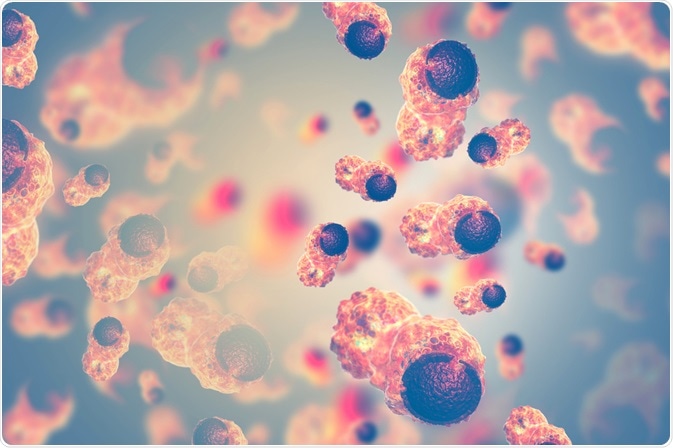Cancer
Globally, cancer is one of the leading causes of death with 17 million new cases and 9.6 million deaths in 2018. This number is only projected to increase. Current treatments involve chemotherapy, radiation, and surgery.

Image Credit: Crystal Light/Shutterstock.com
Through these forms of treatment, the tumor tissue is damaged but so is the surrounding healthy tissue leading to extensive side effects. Cancerous cells have hallmarks that are not only indicative of the tissue but can also be used to obtain further useful information; this was first described by Hanahan and Weinberg in 2011.
These hallmarks are anti-cancer defense mechanisms that are embedded in our cells and must be breached by a prior healthy cell which is on track to become a cancer cell
Current treatments and overcoming challenges
Since the characterization of these novel hallmarks, treatment methods have been investigated, of which nanomedicine is one of them.
Nanomedicine is defined as nanotechnology (the use of materials between 1-100nm) applied to health and medicine.
Nanomedicine has attracted a significant degree of interest within oncology in recent years, due to the potential to overcome problems associated with current chemotherapy and radiotherapy approaches.
The advances in chemistry and material sciences have led to the development of nanomaterials that have an intrinsic cytotoxic activity or enhance the efficacy of current therapies. Furthermore, these novel drug delivery systems can decrease the side- effects of standard drugs.
Current problems within cancer therapy include low specificity, rapid drug clearance, and biodegradation and limited targeting.
The properties of nanomedicines such as their size; high surface to volume ratio; a favorable drug release profile and targeted modifications, allowing them to better reach the tumor tissue and release drugs in a stable and controlled manner.
On a similar note, nanocarriers can exploit the leaky vasculature that is commonly seen within cancerous tissue.
They (the cancer cells) often accumulate within the vasculature through the enhanced permeability and retention effect. Another use of nanomedicines is that they can direct the toxicity of the medicine to the tumor tissue whilst the normal tissue is spared.
The poor solubility of small-molecule drugs can also restrict their delivery to the cancerous cells. Therefore by encapsulating drugs within nanocarriers such as a liposome or polymeric micelle, it can facilitate their travel through the bloodstream, this would prevent the rapid clearance and degradation, therefore, improving the bioavailability.
The potential of nanomedicines can extend beyond treatment and to the early detection of cancers as well as combination therapies. Thereby treating the tumors earlier and in a more effective manner.
Current uses of nanomedicines in cancer therapy
The ability of nanomedicines to carry multiple therapeutic agents may increase their ability to improving cancer treatment. Protein- drug conjugated nanoparticles consist of proteins directly linked to the drug molecules where the link is biodegradable upon arrival in the targeted cell.
However, this delivery method can face challenges; the link may be prematurely broken down through the action of proteases and redox- altering agents are often found within the blood circulation.
Through ongoing research, this method of delivering therapeutic agents allows increased control in the delivery of cytotoxic drug molecules thereby lessening the side effects.
These conjugated agents typically have a long half-life in vivo facilitating its delivery to the tumor site. Within an ovarian cancer study, bortezomib and doxorubicin co-loaded nanoparticles were able to exhibit a synergistic effect.
It has also been observed loading multiple siRNAs alone or together with other drugs can help increase the sensitivity of the tumor to the treatment.
However, the successful delivery of these chemotherapeutic agents depends on the properties of biological barriers involved in cancer.
Conversely, there is a well-characterized example of inorganic gold nanoparticles. Gold itself has been extensively used in both the detection and treatment of cancer, both directly and indirectly.
Its strong optical absorbance properties allow It to be used for the detection of cancer, whilst its photothermal properties make it suitable for anti-cancer therapy. Drug surfaces may be conjugated to the surface of gold nanoparticles, whilst its hollow interiors allow for increasing the encapsulation efficiency.
Gold is favored through its ability to control the drug release by adding a layer of thermo-responsive polymers that shrink in the heat and expand in cooler temperatures.
This not only allows for the control of the diffusion rate of the loaded drug particles, but it can allow the delivery of the drug to specific regions, though, shining a laser, for example. This, in turn, increases the effective drug loading while minimizing the nonspecific toxicity,
Nanomedicine in the future
We have already witnessed great advances in nanomaterial science. However, there is a constant drive for innovation to refine the nanomedicine systems further even on the single-molecule level.
The developments towards this goal will have an enormous therapeutic impact by enabling more therapies that might not otherwise be viable due to technical limitations.
The domain of nanomedicine still needs to develop further so we have a comprehensive understanding of the nano-bio interface. It is still an emerging, interdisciplinary field where its clinical use is still relatively limited.
Even still, in vivo, we have a basic understanding of their biological effects. In that sense, they are flawed as it is still in the early stages of development. However, the precise and individualized nature of nanomedicines represents a key opportunity in medicine.
References
- Cancer statistics. Available at: https://www.cancerresearchuk.org/health-professional/cancer-statistics/worldwide-cancer
- Tran, S., DeGiovanni, P. J., Piel, B., & Rai, P. (2017). Cancer nanomedicine: a review of recent success in drug delivery. Clinical and translational medicine, 6(1), 44. https://doi.org/10.1186/s40169-017-0175-0
- Jing Wang, Yiye Li, Guangjun Nie, Yuliang Zhao, Precise design of nanomedicines: perspectives for cancer treatment, National Science Review, Volume 6, Issue 6, November 2019, Pages 1107–1110,
- Cell. 2011 Mar 4;144(5):646-74. DOI: 10.1016/j.cell.2011.02.013. Hallmarks of cancer: the next generation. Hanahan D1, Weinberg RA.